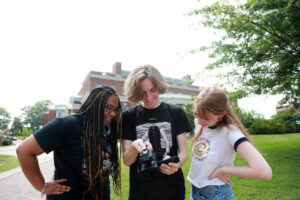
The mini-movie she made with her teammates shows Alanah Cleare falling asleep while studying in the University of Mary Washington’s Hurley Convergence Center. In the AI-assisted dream sequence that follows, she awakens on Campus Walk surrounded by fantastical fruit – talking pineapples and combustible berries that swirl up to the sky and explode in a rainbow.
The ethereal composition was created by UMW junior Owen Wheeler and senior Chloe Adler, along with Cleare, who graduated from UMW in May but returned this summer to take part in a faculty-guided research opportunity. The group was led by Assistant Professor of Communication and Digital Studies J.D. Swerzenski.
Their two-minute Berry Blasters movie was part of a project called “Cameraman vs. Machine,” designed to assess the value of artificial intelligence for student filmmakers. It was one of four presentations delivered last month at Mary Washington’s Arts, Humanities and Social Sciences Summer Institute (AHSSSI) Symposium. The fourth annual event – which also explored AI’s potential in creative writing, the role of eye movements in memory, and the evolution of phonological features – was the culmination of five weeks of scholarly summertime work.
“When we’d run into issues, Dr. Fallon would remind us that we were undergraduate students doing graduate-level research,” senior Michael Boehmcke told symposium spectators who gathered inside Combs Hall to hear the groups’ trials and tribulations, along with their triumphs.
Boehmcke, a creative writing major who transferred to Mary Washington from Tidewater Community College, joined senior Bex Colley and junior Ainsley Graf for their project, “Atoms of Sound: An Encyclopedia of Phonological Features,” led by Associate Professor of Linguistics Paul Fallon.
“They’re getting close mentoring, plus research, writing and editing, and technical skills,” Fallon said of AHSSSI and his group, which catalogued the abstract components of speech sounds used by the world’s more than 7,000 languages. “I think this is why they came to Mary Washington. This is the type of experience they were looking for.”



A résumé- and career-building offering, AHSSSI is meant to provide a personal touch, with plenty of access to teammates and professors. The process, which also comes with a paycheck for participants, strengthens students’ skills in critical thinking, analytics, data literacy, website design, teamwork, public speaking and more.
For senior English major Asunta Ross, getting involved in “Experiments in Generative AI, Literature and Machine Learning for Creative Writing,” with Associate Professor of Communication and Digital Studies Zach Whalen was an opportunity to try something new. Ross and her teammates, junior Kenzie Lotz and sophomore Cory Wagaman-Eure, paired AI-training frameworks like Unsloth and Ollama with classics like A Christmas Carol and Uncle Tom’s Cabin.
“We researched different ways AI can pick up on the stylistic choices of authors,” Ross said. “Working with AI is an entirely new concept for me, so I learned a lot.”
Senior Loren Osborne chose to delve deeper into cognitive psychology with “Warming Up: Eye Movements May Improve Recall in Consistently Handed People,” guided by Assistant Professor of Psychological Science Marcus Leppanen, who led this year’s AHSSSI.
Together with teammates and fellow psychology majors – seniors Avery Gallahue and Nyah Speicher, and junior Morgan Crabtree – she ran trials in Mercer Hall’s Eye Tracking Lab, using the psychology department’s Tobii Pro Fusion Eye Tracker. The group explored concepts like Saccade-Induced Retrieval Enhancement and used tools like the Edinburgh Handedness Inventory to study how rapid-eye-movement warmups might provide memory benefits for people who mostly use only their right or left hand.

“This program has allowed us to build our method and test it on a small scale, so we may now look forward to refining it further and gathering data from a larger sample,” Osborne said of the work the group plans to continue next year.
Meanwhile, the “Cameraman vs. Machine” team used models like Sora and Firefly to examine AI’s ability to translate speech, generate images and understand filmmaking terms like “close-up” and “tilt” … and to create productions like the colorful dream sequence starring Cleare.
“Can these AI tools work for us or do they take away from the creativity of filmmaking?” Swerzenski said. “That’s the spirit of AHSSSI. We get to really dig into these things.”








Impressive! thanks for sharing
Jerri
Jerri Barden Perkins,MD